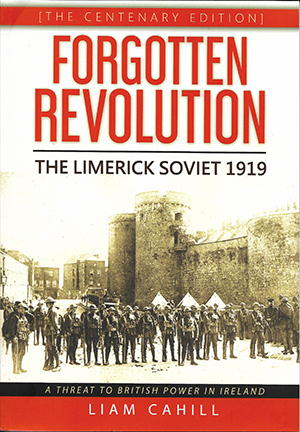FORGOTTEN REVOLUTION: THE LIMERICK SOVIET 1919
Published in Book Reviews, Book Reviews, Issue 1 (January/February 2020), Reviews, Volume 28LIAM CAHILL
Orla Kelly Publishing
€15
ISBN 9781912328413
Reviewed by: D.R. O’Connor Lysaght
 D.R. O’Connor Lysaght’s The story of the Limerick Soviet appeared recently in its fifth edition.
D.R. O’Connor Lysaght’s The story of the Limerick Soviet appeared recently in its fifth edition.
The Limerick Soviet of 1919 was a major episode in the Anglo-Irish War. It involved the population of Ireland’s fourth largest city, with 14,000 participating actively. Yet it is less known than the contemporary isolated battles at Soloheadbeg and Knocklong. This is partly deliberate. In the 50 years that followed it was examined in only two published articles. The subsequent half-century saw it mentioned far more often. Yet at the start of 2019, its centenary, an Irish Times survey of 1919 ignored it totally. The reason for this seems to lie in the strike’s social politics. Unlike the military engagements, it was a specifically working-class initiative carried almost to the logical conclusion of claiming state power. As such it represents a lacuna in the standard history of nationalists uniting in armed struggle for a united independent bourgeois Ireland.
In 1990 Liam Cahill made a major breach in this wall of silence when he published the original edition of this book. For the soviet’s centenary he has published an expanded version. It is very welcome, containing as it does much new and original material. The problem lies with the presentation of that material. In his Foreword, Cahill divides his book’s schema into two parts, the first being descriptive, the second analytic. The former achieves its aims but the latter is less successful.
The original work tended to take a fatalistic approach to its subject, as if any working-class project for taking state power was doomed automatically. This is not the case in the expanded edition. The trouble is that it replaces pessimism with general confusion. Too little of the new information adds much to the basic narrative. It gives the reader interesting data that do not add to any consistent argument. The effect is like that of an article on this subject by Jim Kemmy, whose publicising of the soviet had its effect weakened by his political ambivalence towards the cause it served.
The confusion does reveal parts of two particular analyses, one essentially correct, the other far more dubious. The first of these is the recognition that it was objectively possible for the workers’ movement to take state power in Ireland and, perhaps, throughout this archipelago in 1919. What remains unclear is why it failed to do so. Suggestions are made as to the causes for the failure. Labour Party leader Thomas Johnson’s ideological leadership after Connolly and Larkin looms large, as does the inevitably heterogeneous political nature (including constitutional nationalists and unionists) of their movement’s syndicalist organisation. There were more basic components of the weakness. Syndicalism did not provide any more analysis of the nature of state power than the social democracy that it rejected. Connolly’s vision was that its industrial republic would supersede the political state. This left open the question of whether or not the change would come peacefully. Many of the rank and file would have said that it would not. After Connolly, their leaders might have agreed but would have felt that any seizure would be premature without total union organisation. Their theoretician, Thomas Johnson, pinned his expectations on a peaceful transfer and influenced his colleagues accordingly. The result was that the necessary core of any state, its armed force, as represented by the Irish Citizen Army, was left as an isolated sect confined to Dublin and Cork.
One valuable contribution shows implicitly that this may not have been inevitable. This book describes how class differences caused the Limerick Volunteers to divide into two battalions. During the soviet, their rivalry was suppressed because the Volunteer representative on the strike committee was the commandant of the East Clare Brigade, Michael Brennan. In practice, although neutral geographically, he was of big farming stock, a voice on the soviet for property.
Less central to the book’s analysis but a greater weakness is its handling of the role of the Irish Republican Brotherhood (IRB). Cahill describes this as ‘crucial’ to the soviet. In fact, his account bases this statement on a series of assumptions. Certainly IRB members took part in maintaining the strike. The only definite evidence that its leadership intervened (unmentioned by Cahill) is Richard Mulcahy’s, that he inspired Johnson with the idea of evacuating Limerick city, exposing himself as of the same view as the city’s mayor and bishop: that the stoppage should be of purely symbolic importance. Moreover, the initiative to strike came from the workers in Cleeve’s factory, a large proportion being women. This fact reduces the likelihood of the soviet being an initiative of an overwhelmingly masculine organisation.
These criticisms should not obscure this work’s value as a description of what remains an unduly neglected fight in Ireland’s independence struggle.
















